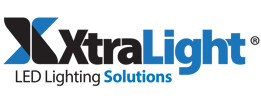Between the vast number of grow lights on the market today, it has become challenging to understand what system is truly right for your grow application. With all of these options, how do you know what is right for you? If you haven’t made the transition to LED, what factors should you consider?

LED's are revolutionizing indoor horticulture, offering a more efficient yet longer lasting lighting solution providing growers more control over their plants-growth than ever before. Not only are professionals achieving optimal efficiency and higher yields, enthusiasts are enjoying the advantages on a smaller scale too. Between the vast number of grow-lights on the market today, it has become challenging to understand what system is truly right for your grow application. With all of these options, how do you know what is right for you? If you haven’t made the transition to LED, what factors should you consider?
Here's a start:
_______________________________________________________________________________________________________________________________________________________________________
Grow Space:
When looking to invest in an LED grow-light, grow space should be the first thing you consider within your specific application requirements. Grow space will determine your recommended watts, photosynthetic active radiation [PAR], photon flux [PPF], and mounting-height. You will need to measure your entire garden, and calculate the square footage.
Buying the wrong light whether over-powered or under-powered will have a big impact on the growth of your plants. If your plants receive too much absorbed light (PAR1), then your plants will become sun-bleached and die. If your plants do not receive enough light (PAR1), then grow-times and overall yield will see set-backs. Here are some general references to help you determine what light intensity you might be looking at based on your grow space:
- 2 x 2 feet (4 square feet) = 150 Watts
- 2.5 x 2.5 feet (6.25 square feet) = 250 Watts
- 3 x 3 feet (9 square feet) = 400 Watts
- 4 x 4 feet (16 square feet) = 600 Watts
- 5 x 5 feet (25 square feet) = 1000 Watts
Note: Some fixtures are much more efficient in delivering absorbed light to the plant (Photosynthetic Active Radiation [PAR], so make sure to compare PAR values between fixtures as PAR and watts do not always maintain the same ratio.
PAR1: Photo-synthetically active radiation is defined as the spectral range of solar radiation from 400 to 700 nanometers that photosynthetic organisms are able to use in the process of driving photosynthesis.
Humans Use Lumens, Plants Use PAR, PPF, PPFD and Photon Efficacy:
When investing in a grow-light, the only metrics you need to understand to make an informed purchase is PPF, PPFD, and Photon Efficacy. The accuracy of these variables are heavily relied on by scientists, researchers, and industry leaders alike.
- Photo-synthetically active radiation [PAR] as mentioned above is defined as the spectral range of solar radiation from 400nm-700nm used in plant-based photosynthesis.
- Photosynthetic Photon Flux [PPF] is a measurement of how much PAR the light fixture is producing each second. This data is measured using a special piece of research equipment called an Integrated Sphere. All emitted photons are captured. measured, and converted into a unit of measurement called micromoles per second (μmol/s).
- Photosynthetic Photon Flux Density [PPFD] is measured over a one meter square area and converted into a unit called micromoles per square meter per second [μmol/m2/s].
- Photon Efficacy hence the name, determines the light fixtures efficiency in converting electrical energy into emitted photons of PAR. This metric is measured in μmol/J, and the higher the number listed by the manufacturer, the more efficient the fixture is at converting electricity into PAR.
Spectral Power Distribution:
When looking to invest in an LED grow-light, spectrum power distribution [SPD] is one of the most important factors in determining a lights quality. Different plants and growth-stages alike require varying spectrum's and intensities in order to achieve optimal results. This is due to the countless number of chloroplast within plant-cells that each absorb different wavelengths of light.
Until 2014, horticulture experts had avoided LED technology entirely as LEDs could not supplement necessary blue and cyan [400nm-495nm] wavelengths of light. Blue light is a critical component of photosynthesis during vegetative and flowering stages of plants that high-pressure sodium and other grow-lights have offered for years where LEDs could not.This was until Japanese Professors Isamu Akasaki, Hiroshi Amano and Shuji Nakamura from Japan won the Nobel Prize for Physics by creating the first blue LED in early 2014 [2014 Nobel Prize for Physics].
Now in 2020 through LED supplementation, we can provide a better spectrum, consume one-third of the energy, and offer a product that will last 10 times longer than any HPS or CFL grow-light. Full spectrum grow-lights boost overall yield, quality, and can even reduce plant to harvest time.
Here is a visual comparison of spectral distribution between our 600W PowerGrove Full Spectrum horticulture light and a standard 1000W high-pressure sodium light:

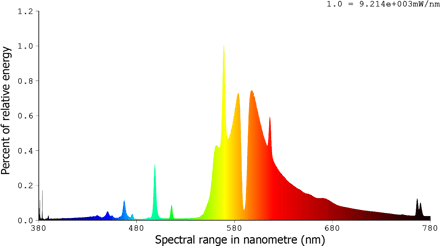
600W PowerGrove Full-spectrum 1000W High-Pressure Sodium
As seen on the charts above, the PowerGrove full spectrum mix provides not only a higher saturation of light, but a higher intensity at every wavelength of visible and non-visible light. This proprietary blend of PAR and UV/IR focused led diodes has been meticulously optimized through trial and error to perfectly match plants chlorophyll absorption peaks. This will drive increased ATP synthesis within the plants mitochondria and can result in higher yields, reduced plant-to-harvest time, and increase THC/CBD concentration in cannabis plants.
To learn more about our line of indoor horticulture lights please click here.
Maintenance Costs:
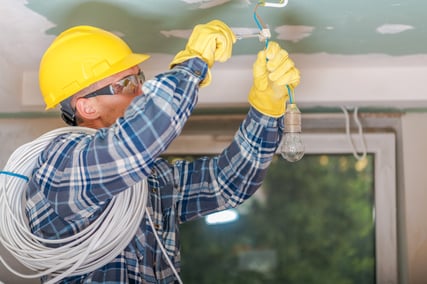
Whether you are a business owner seeking large-scale industrial applications, or simply a horticulture enthusiast growing from your home, everybody pays utilities.
When comparatively indexed to any other lighting solution, LEDs have repeatedly demonstrated their reliability, efficiency, and longevity in a wide-variety of applications. Unlike compact fluorescent lighting [CFL], and high-pressure sodium [HPS] bulbs LED's will not "fail" or "burn-out". Instead, LEDs experience something defined as "lumen depreciation".
Lumen Depreciation occurs when an LED experiences a light output decrease greater-than or equal-to 30%. These attributed features of LED technology have proven their attractiveness to commercial growers in particular as warranties and expected life-spans can double or triple in comparison to market alternatives.
Thermal Management:
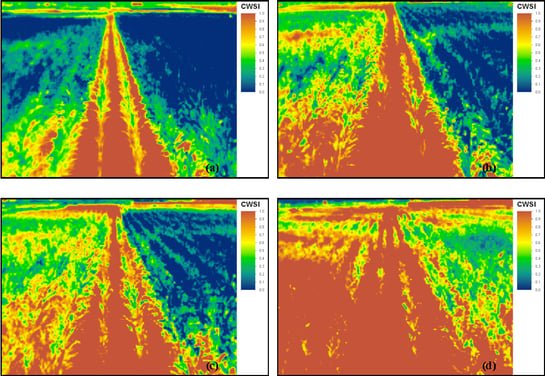 One of the most commonly over-looked benefits encompassing LED's is "reduced thermal output". Operating temperature is the main determinant for an LED's life-span, and if you are able to reduce operating temperatures you will increase both the life-span and efficiency of your light. This plays a valuable role within horticulture as being able to more accurately control grow-room temperatures plays a key-role in determining plant quality.
One of the most commonly over-looked benefits encompassing LED's is "reduced thermal output". Operating temperature is the main determinant for an LED's life-span, and if you are able to reduce operating temperatures you will increase both the life-span and efficiency of your light. This plays a valuable role within horticulture as being able to more accurately control grow-room temperatures plays a key-role in determining plant quality.
The benefits go further as in some environments, LEDs will reduce air-conditioning expenses because of their heat-reduction properties.
Although in small applications benefits are more limited, in large industrial and commercial applications LED's can provide significant energy savings during summer months. One of our recent customers "Major Tool & Machine" reported a 3-year ROI and an immediate 30% in energy-savings since we produced their latest ultra-efficient lighting solution. If you are interested in a free lighting assessment, please click here.
Company Brand & History:
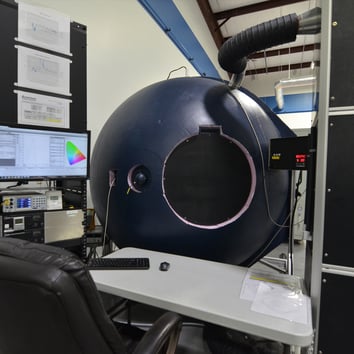 With so many brands in the horticulture market, your choice becomes even more difficult when considering the numerous options available. The first thing to consider is not only how long the company has been in existence, but how much lighting expertise do they really have?
With so many brands in the horticulture market, your choice becomes even more difficult when considering the numerous options available. The first thing to consider is not only how long the company has been in existence, but how much lighting expertise do they really have?
You can go on amazon and buy a fixture that makes similar performance claims at a much lower price-point, however, there is no quality control and no testing evaluations to ensure that the product actually performs as claimed. Some lighting enthusiasts are even going as far as testing some products only to see significantly lower metrics across the board.
Legitimate lighting manufacturers have experienced product engineers who understand the science behind lighting. In addition to engineering experience, they will have had a history of successfully completed lighting projects. With over 34 years of experience in the lighting industry, XtraLight credits its successes to adaptability within the quickly innovative industry. With our in-house partner American Testing & Assessment Laboratories (One of the 36 NVLAP credited laboratories in the US, Lab Code 201019-0.), we have spent countless time and resources developing a proprietorially optimized grow spectrum using our integrated sphere.
So when you are making a final decision, take your time to understand what you need vs. what you want.
Material and Component Quality:
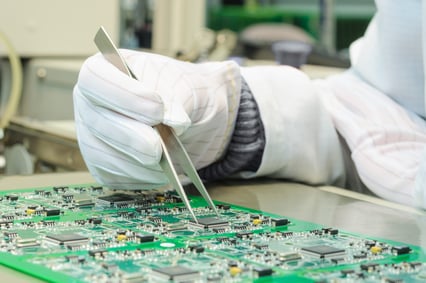 Long term use within indoor-grow
Long term use within indoor-grow Conclusion:
Whether you are an industry professional or simply a horticulture hobbyist, trying to understand which grow light is best for you can be understandably difficult. By writing this article we hope you can reference this as an all-in-one guide to help you avoid making an uninformed decision, and gain the most out of your investment.
Remember: Grow Space, Spectral Power Distribution, Maintenance Costs, Thermal Management, Company Brand & History, Material & Component Quality.
For more information on the PowerGrove visit https://info.xtralight.com/powergrove-led-grow-light or click the button below
